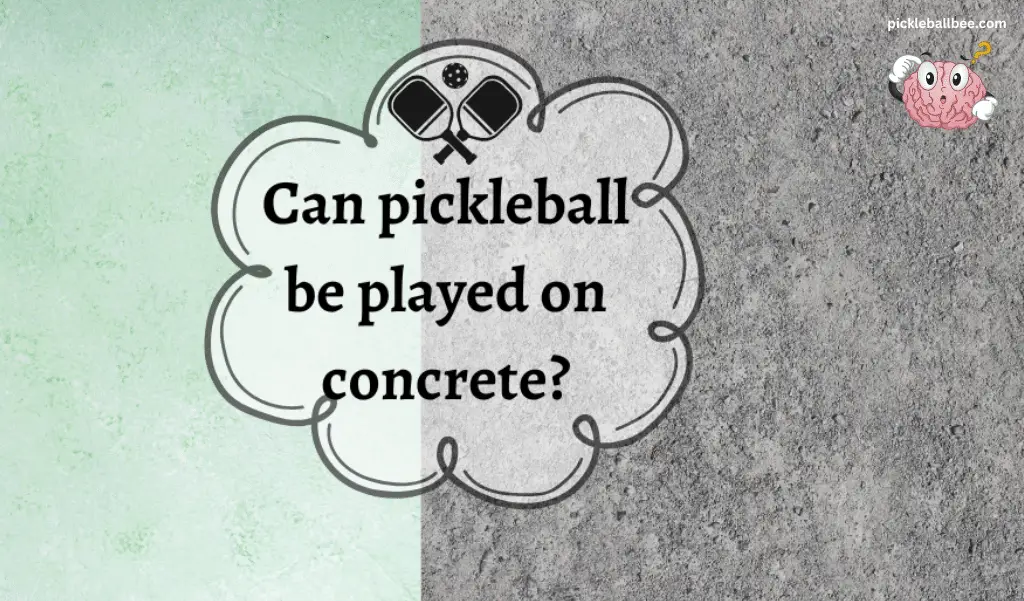When you first wonder about your place in the world of pickleball, it’s crucial to understand that your skill level is more than just a number. Getting a rating is not only about being ranked; it’s a way to gauge how good you are at the game and know what you need to improve. There are several different ways your ability can be assessed, and each system offers a unique perspective. Whether you take a short quiz or get evaluated through a series of matches, each method helps you learn more about your strengths and weaknesses. For anyone keen on elevating their pickleball game, understanding the ratings is important.

Pickleball Self-Rating System
Diving into the pickleball self-rating system can be an enlightening experience. This system works on a simple method where you give yourself a rating on a scale between 1.0 and 6.0. It’s exactly what it sounds like you assess your skills based on certain criteria, requiring you to be utterly honest with yourself. This means that you have to evaluate your capabilities genuinely. Luckily, the USA Pickleball Association offers a helping hand by publishing a list of guidelines detailing how you should score yourself. The score you get ultimately depends on how well you’ve mastered the fundamentals of pickleball, as per their instructions, and follow a structured approach.
Pickleball ratings chart
| Self-Rating Score | Self-Rating Guideline |
| 1.0-2.0 | If you’re quite new, with only a basic understanding of the game, this is for you. |
| 2.5 | At a 2.5 level, you can sustain a short rally with other amateurs, and you understand the scoring system to some degree. This is the stage where your basic skills are being solidified, and you’re beginning to get a grasp of the game’s strategic aspects. |
| 3.0 | At this level, players are starting to grasp court positioning and can keep scores correctly during games. You might find yourself struggling to maintain a dink rally or avoiding using your backhand. While your forehand and serve are passable, your volley often lacks direction. Playing in tournaments is a challenge, and your third shot still needs refinement. |
| 3.5 | Players are now starting to be more consistent and controlled with their dinks, volleys, and forehands. You’re able to deploy your backhand when necessary, showing improved skill. Serves are getting more accurate, and you’re developing a better strategy for the game. Quick movement into the non-volley zone is becoming a strength, and you know the difference between a hard and soft game. You can sustain a short rally and are starting to get an idea of stacking and its uses in gameplay. |
| 4.0 | You’re hitting your forehands, serves, and volleys with good control, depth, and speed. Your backhand can now hit with moderate success, showing significant improvement. You can effectively mix your third shot with both power and levels to diversify your play. The dink game is improving, and you’re able to spot an attackable ball when you see it. The number of unforced errors is decreasing, showing greater precision in your gameplay. You’ve got the hang of stacking and using it to your advantage, starting to exploit your opponent’s weaknesses and attack them more strategically. |
| 4.5 | Achieving a high level of consistency in your forehand, with the ability to vary speed, power, and spin. Your serve is effectively directed, and your backhand can block even hard volleys. The third shot is intentionally and consistently placed exactly where you want it. Your dink game is advancing, with a success rate that keeps improving, changing types of shots as needed. Footwork and weight transfer are good, enhancing how you play with your partner, including easily stacking. You’re able to adapt to various situations, maintaining high-level skills in all aspects of the game. |
| 5.0 | You can hit all shots at a high level, with ability in both forehand and backhand, controlling spin, pace, and aim. Court positions are mastered, enabling effective dinks, and drop shots, and making opponents move strategically. Knowledge of how to use a good rally to create an opportunity to attack, including third drop and drive shots. The ability to control volleys, placing them at the opponent’s feet, and blocking or neutralizing hard shots toward you. A refined skill set that combines agility, strategy, and precision, making you a formidable player on the pickleball court. |
| 5.5 and up | Rating yourself at 5.5 or above indicates you’ve made significant strides in the game, far from being delusional; you’re now in the league of pros and semi-pros, showcasing exceptional skill and strategy on the court. |
Pickleball skill levels
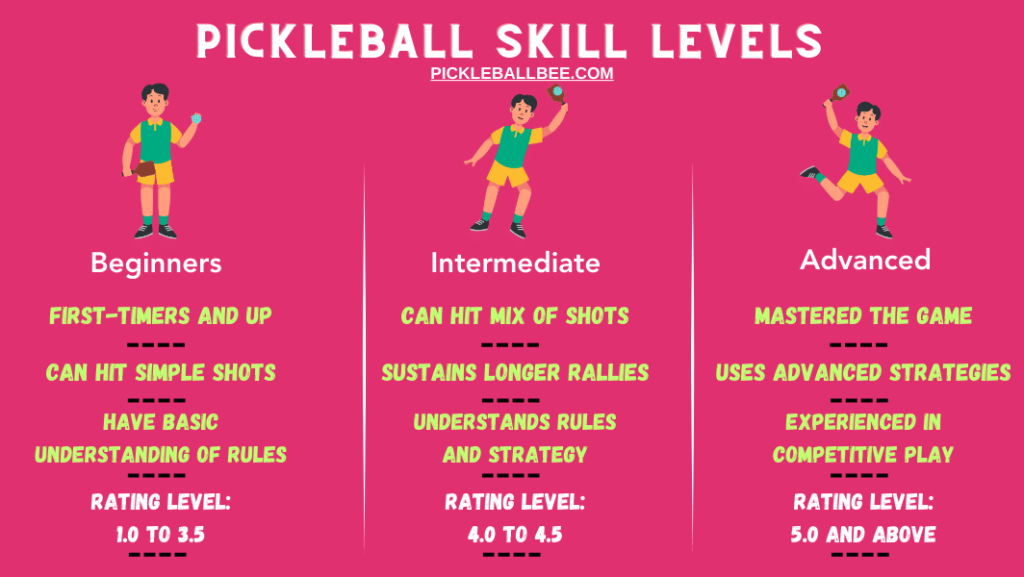
If you’re not yet ready to give yourself a score out of 6, consider a simpler system known as the general pickleball skill level, which offers three options: Beginner, Intermediate, and Advanced. This system is utilized by clubs and leagues to classify players, offering a great way to divide players and ensure everyone has fun playing together.
Beginners typically range from just starting to play for the first time, being able to sustain a short rally, and starting to try backhand shots. This category is for those who can hit simple shots and are gaining a basic understanding of the rules and strategy. The beginner level usually spans from 1.0 to 3.5 on the skill chart.
Intermediate players have developed their skills beyond the basics, while those in the Advanced category display high proficiency in play and strategy. This pickleball rating system assists players in all categories to find their place and track their improvement in the sport.
As someone who’s spent countless hours on the pickleball court, I’ve seen a wide range of players from beginners to the advanced, each striving to improve their rating. The rating system in pickleball is quite straightforward, but understanding where you fit can be a bit tricky, especially if you’re hovering around the 4.0 to 4.5 mark. This group, often the largest at any local club, represents intermediate players. They are well-versed in the rules and strategy of the game, and able to sustain a rally with a combination of shots, including confident backhands and a bit of spin.
A key trait of these players is their ability to aim well and don’t make unforced errors often. It’s fascinating to watch and even more thrilling to be part of this dynamic group.
Moving up the scale, those with a score of 5.0 and above are considered advanced. These are the players who have mastered the game. They bring a different level of play to the court, showcasing remarkable skills that go beyond just hitting the ball. What sets them apart is their strategic thinking, accuracy in shot placement, and the ability to read their opponent’s moves. The journey from intermediate to advanced is not just about physical skills; it’s a mental game, a test of patience, and a lesson in persistence.
As a pickleball enthusiast, reaching this level is a dream for many, including myself. It’s a journey filled with challenges, but the satisfaction of mastering this fun and engaging sport is incomparable.
The journey from being an intermediate player to reaching the advanced stage in pickleball is not just about skill enhancement but also about embracing the finer tactics of the game. As someone who once stood on the threshold of this transition, I remember feeling intimidated at the idea of playing against more experienced players. This stage is all about overcoming fears, learning to spot weaknesses in your opponents, and striking with precision. It’s a period where growing confidence plays a key role in one’s development.
In contrast, advanced players are the epitome of skill and strategy in pickleball. They execute all types of shots consistently and showcase an advanced level of game understanding. Watching them play, with their effortless shots and strategic mastery, is both inspiring and enlightening. The pickleball rating system serves an important purpose here, as it helps in dividing open play sessions, ensuring everyone plays with peers of a similar skill level.
This organization is crucial for maintaining the fun and competitive spirit of the game for players at all levels. Witnessing these skill levels firsthand is not just exciting but also a constant reminder of the growth and potential within this sport.
Why is knowing your pickleball rating important?
Understanding your pickleball rating is crucial and can be looked at in two ways. Whether you’re a beginner or a pro, it’s not enjoyable to play against opponents who are at a different level than yours. For instance, playing against someone way more advanced can be overwhelming, while competing against those with less skill might not provide enough challenge. This is where knowing your rating makes a significant difference. It helps work out matchups that avoid frustration, aligning you with players of similar abilities so that everyone can enjoy the game to the fullest.
As you progress in pickleball, this knowledge becomes even more valuable, especially when registering for tournaments and events. A clear understanding of your skill level ensures you’re in the right category, facing appropriate challenges. It’s not just about preventing mismatches; it’s about encouraging fair competition and personal growth in the sport. The rating system, therefore, is a vital tool for navigating your development and enjoyment of the game.
How to improve your pickleball rating
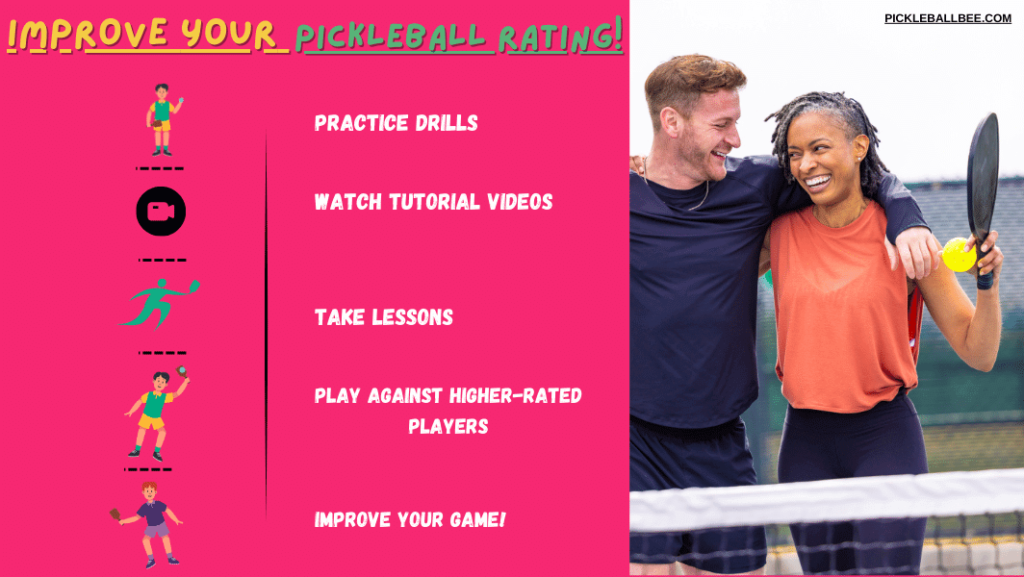
Navigating the path to improve your pickleball rating can often seem like solving a million-dollar question. The simple answer lies in the commitment to get better at the game. In my personal experience, the best way to elevate your play is through consistent practice. Make it a habit to play as much as possible, focusing on challenging and varied drills. I’ve found it particularly beneficial to play against a skilled opponent; this not only tests your skills but also enhances your game strategy. Additionally, watching tutorials on YouTube provides valuable insights, boosting your abilities both on and off the court.
Taking pickleball lessons is another great way to boost your rating. A knowledgeable coach can hone your skills, give you specialized pointers, and offer tips that cater to your unique playing style. These lessons usually introduce new, personalized drills that target your specific areas of improvement. Finally, don’t underestimate the power of pushing your limits. Playing against higher-rated players offers a formidable challenge but doing so does wonders for your skill levels, leading to a noticeable enhancement in your overall game.
USA pickleball tournament player ratings
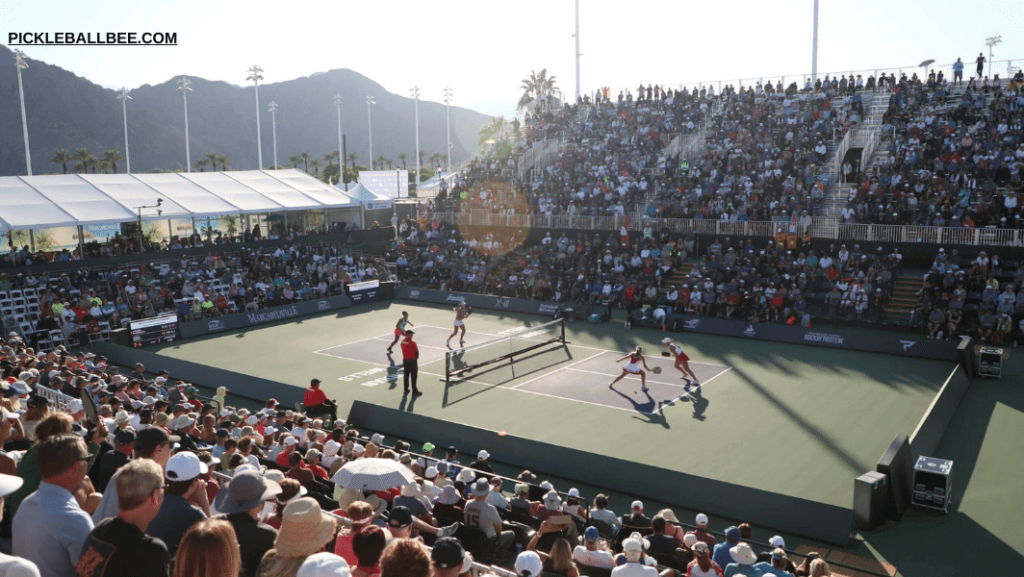
Next up, let’s delve into another intriguing system: the UTPR or USA Pickleball Tournament Player Ratings, formerly known as USAPA ratings. Whenever you hear the term UTPR, remember, it’s the same thing. These ratings are based solely on a player’s previous performance in tournaments. For members who actively compete in competitions, this offers a way to score a more accurate self-rating. The system is purely based on your pickleball playing history but can get a little complicated.
Get your calculators out because UTPR scores range from 0.000 to 6.999. Your score goes up when you win, and down when you lose. However, it only changes when you play in sanctioned, official tournaments. The amount of change uses an Elo rating system, a clever mathematical formula where the winner takes points from the loser’s score. So, engaging in official competitions not only challenges your skills but also directly impacts your national rating.
When you’re involved in pickleball and keen on improving your game, getting to grips with the USA Pickleball Tournament Player Ratings (UTPR) is essential. This system might appear intricate, but its logic is straightforward. The idea is that if a low-rated player beats a higher-rated one, in what could be seen as an unexpected win, the winner takes more points from the loser. This scenario flips when a higher-rated player wins as expected; they gain a lower amount of points. This makes the scoring system both fair and self-correcting. Over time, a player’s UTPR score should genuinely reflect their skill level.
For those playing doubles, the system adds an interesting twist. You add your and your partner’s ratings together and divide by two to get your team rating. It ensures that the combined skill levels are fairly represented.
In terms of practical application, your UTPR pickleball rating is used in tournaments to categorize skill levels. Normally, you’d see a four-digit score, but in a tournament round, you round down to a two-digit number. For example, if your rating is 4.255, you would compete as a 4.0. Remember, you must always play up to your skill level. If you’re rated 4.0, you can’t play in a 4.5 category. Additionally, age also plays a role; if you’re 42, you wouldn’t typically compete in an over-20s bracket but rather aim for a 40s category.
Dreamland universal pickleball ratings

In the evolving world of pickleball, Dreamland Universal Pickleball Ratings (DUPR) stand out as a new and dynamic approach to calculating a player’s prowess. Conceived at Dreamland, a pickleball-based entertainment center in Austin, Texas, DUPR revolutionizes how wins and losses in matches contribute to a player’s ranking.
This rating system, a brainchild of Steve Kuhn, aims to reflect a player’s real skill level. It adapts the Elo rating system, traditionally used in chess, to pickleball match results. The ratings, which range from 2.000 to 8.000, are calculated by considering the weight of each official tournament and recent matches. As players report their wins and losses, their pickleball rating adjusts accordingly in the DUPR record.
What sets DUPR apart is its idea to democratize pickleball skill ratings by creating a centralized hub that verifies and stores match outcomes. Unlike the UTPR system, DUPR offers a more inclusive platform where every match matters, not just those in sanctioned tournaments. This inclusive nature ensures that a player’s DUPR rating is a more accurate reflection of their skill level, as it continually adapts and updates with each played game.
Pickleball ranking organizations
The world of pickleball is vibrant and competitive, with various organizations playing pivotal roles in ranking players based on their performance and participation in tournaments. Here’s an overview of the key organizations and how they operate:
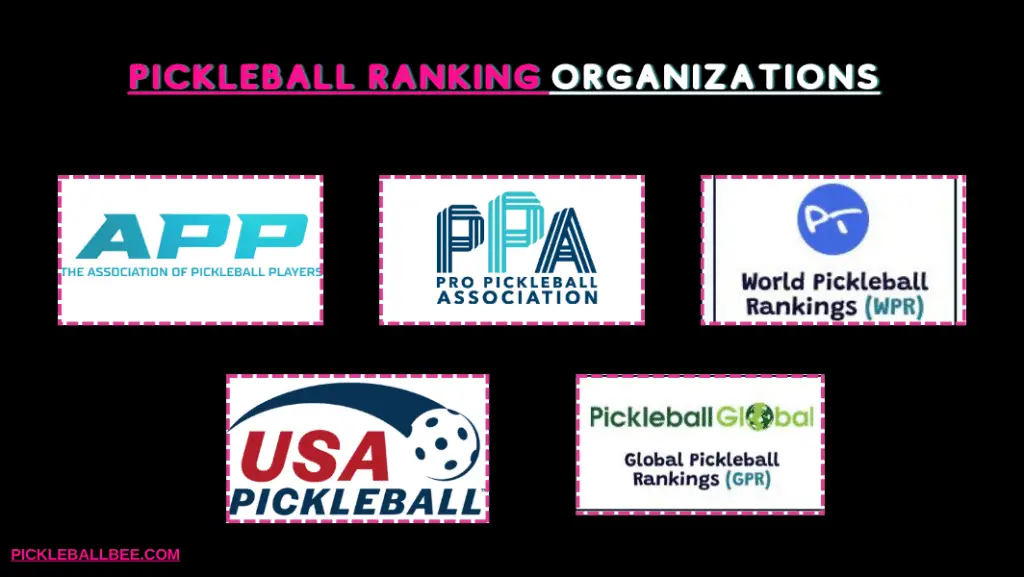
Association of Pickleball Professionals (APP): This organization focuses on both professional and amateur players. The APP standings list is a result of performances in international tournaments. Players looking to compete and improve their ranking can rely on the APP for accurate assessments.
Pro-Pickleball Association (PPA): Specifically catering to professional players, the PPA hosts a tournament tour where players are ranked based on their tournament performance. The PPA tour is known for its big prizes, attracting pros from various regions.
World Pickleball Rankings: Renowned as the gold standard, this organization’s rankings are based on a player’s performance in official competitions. A professional pickleball player’s rank is calculated from their 15 best results in tournaments throughout the year.
Pickleball Global: An emerging pickleball hub, it offers the GPR ranking system, which is gaining traction around the world. This system assigns a standing to players based on an age-based system, like a 19+ singles male player. It considers the 8 best results from the previous 52 weeks.
USA Pickleball: Known for providing the latest news and updates in the pickleball space, they have announced a brand new system for ranking players. The USA pickleball ratings are keenly watched by players across the nation.
What Is DUPR in Pickleball?
Dynamic Universal Pickleball Rating (DUPR) is a comprehensive rating system that spans various aspects of the sport, aiming to be both inclusive and accurate. It’s a global solution to rating pickleball players, employing a 3-digit system that functions on the same scale across multiple playing formats.
This includes singles, doubles, and mixed doubles, and rates players of all ages and skills. DUPR’s uniformity is especially advantageous for those participating in different kinds of games, as it provides a consistent benchmark for player assessment.
What makes DUPR stand out is its broad acceptance and advanced scale. The rating system is designed to accept score differentials, offering accurate player ratings. As a pickleball rating authority, DUPR takes into account not only tournament scores but also rec games, overcoming some of the limitations of other systems. It’s widely accepted as a reliable measurement of a player’s ability, making it a unique rating system for pickleball players.
For those playing pickleball, whether for practicing or enjoying a social game, DUPR offers tangible benchmarks. It helps players not get bogged down in the specifics but rather focus on skills and measurements that matter. This system encourages players to grow and develop, whether they intend to enter tournaments for the fun factor or the challenge of performing against others.
Remember, improvement in pickleball, like any sport, doesn’t happen overnight; even the best players can have days when they perform worse. But with tools like DUPR, offered by organizations like USA Pickleball, players have a clear path to entertain, challenge, and most importantly, develop their game.
How To Get A DUPR Rating In Pickleball
Getting a DUPR (Dynamic Universal Pickleball Rating) is a straightforward yet engaging process. This rating system, recognized as the Global Rating System for Pickleball, rates players based on their match results. What’s unique about DUPR is that it does not consider skill level, location, gender, or age; it focuses solely on performance. The DUPR scale ranges from 2.00 to 8.00, making it accessible to players at all levels, from entry-level to advanced. Additionally, players can self-assess to get an initial DUP rating.
One of the best parts of the DUPR process is its inclusivity and ease of access. The rating is available to anybody free of charge, and getting started requires just a single match result to achieve a DUP rating. Almost any pickleball game you play counts towards your DUPR rating, whether it’s in a recreational or open-play tournament.
You can even record self-posted scores, which will have a direct impact on your rating. An interesting aspect is how unrated players can start building their rating; for instance, if an unrated player posts their score after a game with other unrated players, all participants will receive a rating once they play against a rated player. It’s also important to note that some matches are weighted more heavily than others. Sanctioned amateur and pro tournaments will have a more significant impact on your grade compared to unsanctioned events.
How Are Pickleball Ratings Calculated?
Dynamic Universal Pickleball Rating (DUPR) is a sophisticated rating system in pickleball. It depends on three key factors: the Winning margin, which takes into account the number of points won; the Competition type, distinguishing between tournament, league play, and rec play; and the Result – whether it’s a victory or defeat. This system uses a 2-digit or 4-digit number to rate players. The rating is determined by various factors including the type of competition, the result of the match, the margin of victory, and the skill level of the opponent.
The UTPR (Universal Tennis Rating) is another critical system in pickleball. To calculate a UTPR, only tournaments listed on pickleballtournaments.com can be used. The weighting of a UTPR from a fully sanctioned tournament is 100%, while medal-match-only sanctioned tournaments contribute 80%.
Non-sanctioned competitions have a lower impact at only 60%. UTPRs are updated weekly for four-digit ratings and quarterly for two-digit ratings, which are used to register for tournaments. For doubles, UTPR uses the individual’s average ratings. For example, if one member of a partnership has a 3.500 rating and the other has 3.700, their team UTPR will be 3.600.
Conclusion:
In the quest to improve your pickleball skills, understanding the rating systems is key. That’s it – the rundown of various methods to assess your skill level is not just about numbers. It’s about categorizing yourself into a specific group that mirrors your abilities and ambition. This approach makes your pickleball experience more rewarding, productive, and undoubtedly, fun.
As you check out Pickleballbee, our comprehensive review of the best pickleball shoes, paddles, and nets you can currently buy, remember that the right gear can give you that extra edge. Whether you’re a seasoned player or recently saw your rating improved, selecting the top equipment is crucial. So, go ahead, equip yourself with the best tools, and turn every match into a chance to enhance your game.
FAQS:
-
How do you know your skill level in pickleball?
Determining your skill level as a pickleball player goes beyond just looking at your win-loss record. It’s a holistic assessment of both your physical and strategic abilities. A proficient player exhibits control and consistency in their gameplay, coupled with adaptability to different play styles. This includes mastery over various shots like forehands, serves, dinks, and volleys.
-
What is a 6.0 pickleball player?
A 6.0 pickleball player represents the pinnacle of the sport. This rating is not just a number; it embodies a player who has mastered every aspect of the game. On the court, these players display an exceptional range of shots and an impeccable sense of strategy. Achieving a 5.5-6.0+ rating in pickleball means you’re consistently winning at the highest level of play, competing against the best professional players in tournaments.


